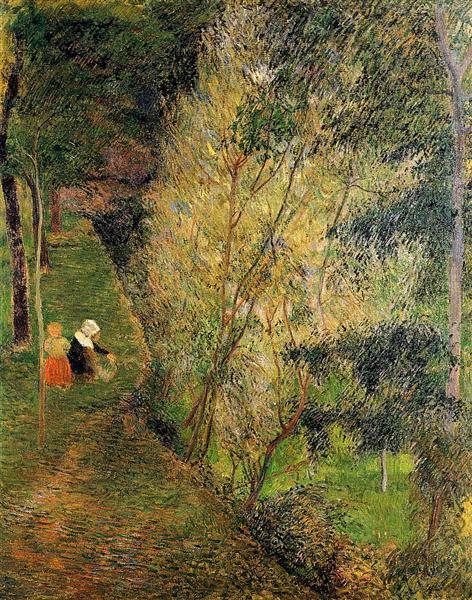Beskrivelse
Paul Gauguin's painting "Pont-Aven Woman and Child", painted in 1886, encapsulates a fascinating intersection between symbolism and figurative representation that characterizes the artist's work. In this painting, Gauguin delves into his search for a visual language that goes beyond mere naturalistic representation, immersing us in a world where form and color carry with them a deeply emotional and symbolic meaning.
The canvas depicts a standing woman, dressed in a white blouse and long skirt, holding a child who appears to rest on her hip. The mother’s natural pose, marked by intimacy and protection, evokes a palpable connection between the two figures. The focus on the bond between the woman and the child resonates with Gauguin’s interest in human relationships and deep emotional states, recurring elements in his work.
The composition is characterized by a vertical structure that guides the viewer's gaze from the lower part of the painting, where the woman's legs are, to the serene expression of the child who peeks out from her side. This use of verticality, together with the abstract background, suggests not only the physical space they inhabit, but also the emotional context in which they are immersed. The separation of forms and background represents a distancing from tangible reality, taking us into a more metaphorical atmosphere.
Colour plays a key role in this work, where warm tones predominate, accentuated by a delicate palette of blues and greens that suggest an imminent, almost primeval natural environment. Gauguin uses a technique of loose, almost decorative brushstrokes that challenge the traditional three-dimensional representation of space, creating a sense of flatness and symbolism that aligns with his style in the Pont-Aven School. This artistic group, of which Gauguin was a central member, explored the expression of emotion through colour and form, rejecting the academic conventions of his time.
The characters portrayed in Pont-Aven Woman and Child are not merely isolated individuals, but representations of a broader cultural and emotional connection. The woman can be interpreted as a maternal figure who embodies the traditions and daily life of the region of Brittany, where Gauguin spent significant time. The way the characters blend into the background suggests a fusion with their surroundings, a recurring theme in Gauguin's work that points to his search for the spiritual and essential in life.
Although Pont-Aven Woman and Child is not as well known as Gauguin's other works, such as The Vision of the Sermon or his later explorations in Tahiti, this painting is representative of the artist's early development of his post-impressionist style. In this sense, the work becomes a prism through which we can examine not only the evolution of Gauguin's visual language, but also the broader dialogue between form, color, and emotion in 19th-century painting.
Ultimately, "Pont-Aven Woman and Child" stands as a palpable manifestation of Gauguin's commitment to exploring humanity in a regional and emotional landscape, amalgamating lived experience with artistic reflection that often challenges the conventional perception of the art of his time.
KUADROS ©, a famous painting on your wall.
Hand-made oil painting reproductions, with the quality of professional artists and the distinctive seal of KUADROS ©.
Painting reproduction service with satisfaction guarantee. If you are not completely satisfied with the replica of your painting, we will refund 100% of your money.

